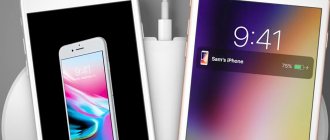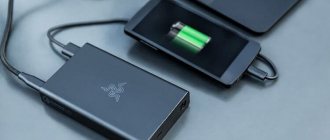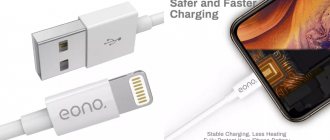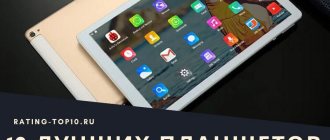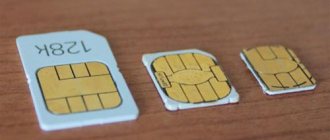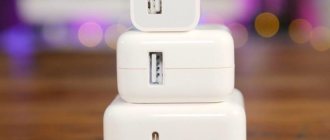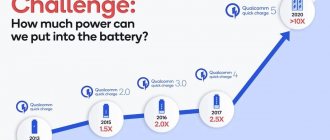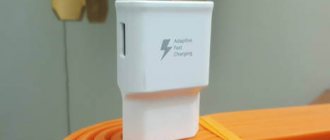Charging guide.
To charge iPhones starting with iPhone 8 and later, you can use power adapters that support USB Power Delivery. The new iPhone 11 also supports high-speed charging, but here's the problem: it comes with a 5W power supply. Exactly the same as the old iPhone 5S, SE and so on. For models with small-capacity batteries, this was not so critical, but in 2022 it’s simply strange to keep the phone at the outlet for three hours, waiting for it to be fully charged.
If there is a problem, there will be a solution: you need a more powerful power supply. I’ll tell you what options there are and what you should pay attention to.
Charger for iPad
The next option is this: buy a 12 W power supply for the iPad and charge it from it. There is a regular USB-A connector, so the included Lightning for iPhone is suitable, you don’t have to buy an additional cable. By the way, if you have an iPad Pro on your household, then you can safely take this same charger and charge not only your tablet, but also your iPhone from it.
Just in case, I’ll make a reservation: some iPads included a 10 W power supply, and some even had a long-suffering 5 W power supply (like the base iPad). So even in the neat universe of Apple tech, there may be exceptions.
USB Type-C 30W Power Adapter
Apple previously released a 29 W adapter, then replaced it with a 30 W model. The unit is notable for the fact that it came bundled with the MacBook 12. Alternatively, you can go further and connect units from the MacBook Pro 13 or 15 to the phone at 61 and 87 W, respectively.
But I don’t see the point in buying such a charger specifically for the phone, but if you have a MacBook on your household, then why not: charging will be at the highest possible speed.
Fast charging can charge your iPhone up to 50% in 30 minutes using an Apple USB-C to Lightning cable and one of the following 18W, 29W, 30W, 61W, or 87W Apple USB-C adapters.
Apple itself allows the use of such charges, and you don’t have to worry about the safety of the battery: the phone itself controls the process and will not “overcharge.”
Do I need any special cable?
An original or certified Lightning to USB cable is required for proper charging operation. It must have an inscription and a serial number of twelve characters.
Using a fake cable will negate all the benefits of fast charging.
At best, the device will not be able to provide fast charging. A warning will appear on the iPhone screen - approximately the same as in Figure 8. It was specially introduced with the release of iOS7 to warn owners of mobile equipment. In the worst case, the cable will short out, causing damage to the gadget or causing a fire.
Apple chargers are expensive, I want cheaper ones
There is no need to skimp on chargers and cables. Therefore, choose accessories from trusted manufacturers, no matter how banal these words may sound. Here are some options:
Aukey PA-Y11: support for USB Type-C Power Delivery 30 W and USB 3.0 Quick Charge for 2990 rubles.
Aukey PA-Y13: support for USB Type-C Power Delivery 46 W, USB 3.0 Quick Charge and USB 5V/2.4A for 3,490 rubles.
Satechi 30W Dual-Port Charger: an option similar to the first Aukey charger with two connectors for 2990 rubles.
Satechi 75W Travel Charger: a whole charging station, I use this myself and recommend it to everyone for 4990 rubles.
Of course, that's not all. You can dig around on the site of our friends Biggeek.ru and find a lot of interesting things.
Huawei SuperCharge
Used by: Huawei
Branded charger from Huawei. Used by the company starting with the Mate 9 model. Compatible with USB Power Delivery, thanks to the Smart Charge protocol.
Charging parameters - 10 V, 4 A, 40 W.
The exact speed has not been announced. In the Digital Trends test, the flagship Huawei Mate 20 Pro with a 4200 mAh battery is fully charged in 1 hour 10 minutes.
Does it make sense to buy the most powerful charger?
Macworld was not lazy and conducted a thorough study, comparing the charging speeds of different types. If you look at the charging speed graph, there is no particular point in overpaying for the most expensive power supplies.
Yes, this is not the iPhone 11, but the iPhone X, for example, is indicative: a 61 W unit has no particular advantage compared to 18 W or 29 W
As an optimal option in terms of price-quality ratio, I recommend a basic 12 W charger for iPad. Or take 18 W and buy an additional USB Type-C to Lightning cable.
Mophie Fast Wireless Charger
If you are looking for fast wireless chargers, then you should check out the Mophie Wireless Charger. Even though it doesn't bring the best value for money, Apple is promoting it in its official stores, which should give you peace of mind regarding quality.
And while it comes with a higher price tag, there's no denying the fact that it has a premium design that looks sleek and functional.
The wireless charger supports fast wireless charging up to 7.5W. This means that even if you charge your iPhone 11 wirelessly, it will still be faster than Apple's built-in charger.
Buy on Ozon: from 6,000 rub.
What are you saying, powerful chargers kill phones!!11
From time to time I see comments, the essence of which boils down to the fact that fast charging is bad, and the battery will soon die.
From left to right: iPhone 11, 5W, 12W, 18W, 30W, 87W adapter
I won’t argue, I’ll just show with my own example. For example, I have been using the iPhone 7 Plus since 2016; I bought it shortly after the announcement and only moved to the iPhone XS last fall. I had an iPhone 7 Plus for almost two years, I never charged it using the included 5 W charger. I used both iPad blocks and Anker and Satechi multiport chargers like those in this article. I try to use only original Lightning cables or proven accessories. In general, the system now shows that 89% of the battery remains. In my opinion, very good for an old man, which I usually charged at least twice a day.
Another example is the iPhone XS. He is almost a year old, I charge from fast chargers, using 18 or 30 W units, as well as charging stations and even an 85 W power supply for the MacBook Pro. Again, two charges per day is common. The phone shows 93%.
I hope that the article will help you with choosing a suitable charger for your iPhone. If you know other proven power adapters or good cables, please share your tips in the comments.
You have repeatedly asked us about the labeling of power supplies that come with Apple equipment:
It's time to dot all the i's.
Modern consumer electronics do not require the user to have virtually any knowledge from the world of physics and electronics. Just buy it, take it out of the box and use it.
However, knowledge of certain parameters, understanding of certain processes and properties will help you choose the right product, use it wisely and not expose the equipment to the risk of failure.
iPhone power supply
This is a standard European power adapter that has been included with all iPhone models and some iPad mini models for several years. Chargers from other regions differ in appearance, but have similar characteristics.
Input
All symbols after this inscription describe the necessary input parameters for the operation of the device.
100-240 V
This inscription indicates that the device is designed for a voltage range from 100 to 240 V. Such power supplies are universal and are made to American (110 V) and European (220 V) voltage standards. When using adapters, European charging can be used in America and vice versa.
Indicates that the power supply is designed to be connected to AC power. All electrical appliances connected to the network are designed for alternating current.
Devices that operate on batteries or accumulators are consumers of direct current, because the battery is a source of direct current.
50/60 Hz
This parameter means the frequency of alternating voltage in the electrical network.
In Russia, this indicator is 50 Hz at a voltage of 220 V, in most countries of North and Central America a frequency of 60 Hz is used at a voltage of 110-115 V, and, for example, in Korea the frequency is 60 Hz at a voltage of 220 Volts.
And this parameter indicates the versatility of the iPhone power supply. But it is worth saying that frequency, unlike voltage, is critical only for devices equipped with electric motors. Thus, hair dryers, meat grinders or juicers produced for sale in different countries will have different operating frequencies.
When operating in an unsuitable power supply (with a different frequency), the devices will not be able to produce the maximum declared power, and with long-term use, the motor may fail.
0.35 A
This parameter also relates to the input voltage and characterizes the current strength. The higher this indicator, the greater the current the adapter can produce at the output.
iPad power supply
Apple tablets come with different power supplies. In the boxes with iPad 123AirAir 2Pro 9.7″, iPad mini 234 you can find a power supply for 10W, and with the iPad 4 and the large iPad Pro they put 12W charging.
Most of the parameters match the parameters of the iPhone adapter. The input specifications differ from the current to 0.45A and 0.5A, respectively. From the weekend - the output voltage will increase slightly to 5.1-5.2 V.
The main difference is the increased output current. Instead of 1A, iPad power supplies have 2.1A and 2.4A.
This allows you to charge larger batteries in tablets, and when connected to an iPhone, it will give less charging time.
MacBook power supply
The Apple USB-C Power Adapter 29W ships with new Apple laptops that have USB Type-C ports. If you have an adapter, you can also charge your iPhone, iPad or iPod Touch.
For 5V consumers it produces a current of 2.4A. This figure is greater than the iPhone adapter and power supplies from most iPads and is equal to the charging current from a large iPad Pro.
Apple does not prohibit using power supplies from some devices to charge others, although sometimes this leads to a little more wear on the battery.
Armed with the knowledge from this article, you can decipher the inscriptions on the power supply from any gadget, smartphone, tablet or laptop.
Don't forget that we publish a lot of interesting things on Facebook. Like, please!
(4.67 out of 5, rated: 9)
One of the main questions that every iPhone owner asks himself is how to properly charge it in order to extend the life of the phone. Therefore, the main thing is to know the main factors affecting the charging of this gadget and follow the recommendations for proper charging.
There are several rules for charging gadgets with lithium-ion batteries, which can be applied not only to Apple equipment, but also to phones from other manufacturers. To properly charge iPhone 7, 8, 10 and other models, you need to adhere to the following rules:
- It is better to charge your phone several times to 60-80% than to charge it once to 100%.
The fact is that the cells of lithium-polymer batteries can reach a certain voltage when charging. Accordingly, the higher the charge level , the higher the voltage and the greater the load it experiences. Ultimately, this all leads to a reduction in the number of possible charging cycles.
- Once a month, completely discharge your smartphone and charge it to 100%.
This manipulation is due to the fact that after a large repetition of small charge and discharge cycles, the battery needs a full cycle from minimum to maximum in order to calibrate the battery.
- Do not leave your smartphone charging all night .
The phone, even in standby mode, wastes battery power, and if it is charging at this time, it is constantly recharged by 1-2%. Which does not have a very good effect on his future condition.
Adaptive Fast Charging
Used by: Samsung
Exclusive Samsung standard. Supported by all company smartphones with Exynos chips, compatible with Quick Charge 2.0.
The parameters are stated to be powerful - 9 V, 2 A (18 Watt), but in practice the characteristics are not justified. The Samsung Galaxy S8 with a 3000 mAh battery takes about 2 hours to fully charge, according to Digital Trends. It's slow. In turn, competitors with 4000 mAh replenish energy faster.
However, these may be precautionary measures. Apparently, Samsung remembers the nightmare with the Galaxy Note 7. XDA Developers found that the flagship Galaxy S8+ has the lowest charging temperature.
Answers to frequently asked questions
Can you charge your iPhone overnight?
If you leave the phone on charge overnight, when it reaches 100% it goes into “recharge” mode . As soon as the phone's charge decreases by 1-2%, recharging occurs, as a result of which the voltage increases, which negatively affects the gadget's battery.
Can I charge my iPhone using an iPad charger?
Yes. Due to the fact that the same proprietary charge controller is built into the chargers of both gadgets, you can safely charge them with one cable. Such a controller allows you to limit the current supply to the device and reduce it after the 80% mark. It also constantly monitors the battery condition and prevents it from overloading.
What is the optimal charging time?
The charging time of an iPhone depends on a number of factors: capacity of the model, service , originality of accessories and use of the gadget while charging.
Basically, the time to fully charge iPhones to 100% is 1.5 - 3 hours. It should be taken into account that the first 80% of the charge comes from fast charging, the remaining 20% from slow charging.
How to charge a new iPhone?
After purchase, take your new iPhone out of the box and connect it to the charger. Perform a full charge cycle , that is, charge to 100% and then discharge to 0%. This is all the necessary operation that needs to be performed.
Can I use an Android charger?
In principle it is possible. But you need to understand that a non-original charger may have different voltage and current values, which may affect the charging time. It is also worth keeping in mind that Android devices use USB connectors for charging, while iPhones use Lighting connectors.
How can you tell if your iPhone is charging?
When you connect your phone to the charger and plug it into a power outlet, it will begin charging. This can be seen by the lightning bolt icon next to the battery icon in the top right corner. When locked, a large battery logo .
Results
Apple relatively recently equipped its smartphones with the fast charging function, because only the latest iPhone models support it, such as: iPhone X, iPhone 8 Plus and iPhone 8. Therefore, if you want to charge older iPhone models faster, not a single fast charge will help you, After all, they technically cannot support the type of high-speed charging.
But, to speed up charging on newer iPhones, you can purchase a more powerful device. As tests have shown, 12W charging will be enough for you to charge your devices quite quickly and, at the same time, be safe for their battery.
If we talk about which device you should choose, it is better to pay attention to wireless powerful docking stations that can not only quickly charge your device, but also have the ability to charge several accessories at once, such as Apple Watch and AirPods.
But, if the budget is limited, then for high-quality and fast charging we can recommend a 7W device, which copes with its tasks quite well.
